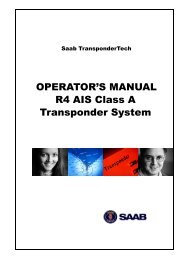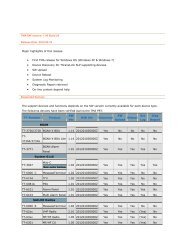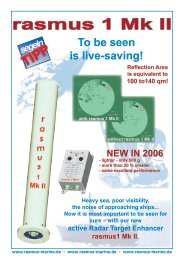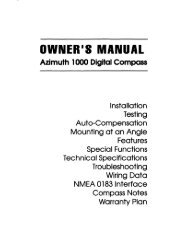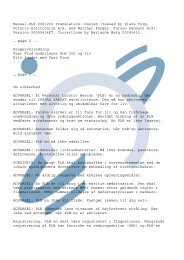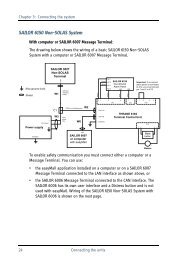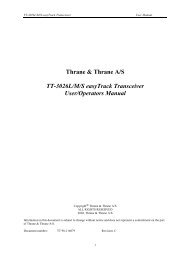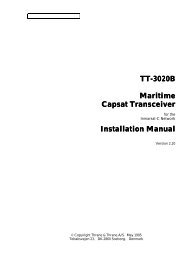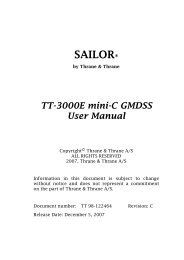Overview of Compass Technology - KVH Industries, Inc
Overview of Compass Technology - KVH Industries, Inc
Overview of Compass Technology - KVH Industries, Inc
You also want an ePaper? Increase the reach of your titles
YUMPU automatically turns print PDFs into web optimized ePapers that Google loves.
effects are known, can be marked on charts, and generally may be treated like an unusual local variation.<br />
In other situations, such as with sunspots or the magnetic interference encountered by a passing vehicle in<br />
a large city, the effects are <strong>of</strong>ten unpredictable, which presents a problem in that the magnetic field<br />
measured may not correspond to direction. Magnetic compasses alone cannot accurately determine<br />
direction in situations where unpredictable magnetic anomalies in the environment distort the earth's<br />
magnetic field. This limitation can be overcome, and it does not apply to magnetic interference originating<br />
from the host platform (deviation), which is relatively permanent, so it can be precisely measured and<br />
compensated using modern electronic technology with sophisticated automatic compensation programs.<br />
3.3.3 <strong>Inc</strong>lination or Dip Angle<br />
The earth's magnetic field is a space vector and can be resolved in<br />
a horizontal component and a vertical component. Direction<br />
corresponds to the earth's horizontal magnetic field, so a magnetic<br />
compass must have the ability to isolate and measure the horizontal<br />
field separate from the vertical. The illustration to the right shows<br />
that the earth's magnetic field is perfectly vertical at the magnetic<br />
poles, and perfectly horizontal at the magnetic equator (which<br />
corresponds very closely to the geographic equator). Everywhere<br />
else there is a combination <strong>of</strong> vertical and horizontal attraction to<br />
differing degrees depending on the orientation on the earth relative<br />
to its magnetic poles. This magnetic dip angle significantly<br />
impacts the performance <strong>of</strong> a magnetic compass from two<br />
standpoints -- geographic coverage and accuracy.<br />
3.3.3.1 Magnetic Dip Angle Effects on Geographic Coverage<br />
60° Magnetic<br />
Dip Angle<br />
Figure 3: Model Showing the<br />
Effects <strong>of</strong> the Earth's Magnetic Dip<br />
At the magnetic poles, the earth's magnetic field is entirely vertical with a dip angle <strong>of</strong> 90°. There is no<br />
horizontal component in the earth's field, so it cannot be used to determine direction. Heading away from<br />
the poles towards the magnetic equator, the earth's field gradually becomes more horizontal. At the<br />
magnetic equator the earth's magnetic field is entirely horizontal, there is no vertical component <strong>of</strong> the<br />
field, so it has a 0° magnetic dip angle. This change in dip angle is the characteristic <strong>of</strong> the earth's field<br />
which prevents a conventional card compass calibrated from the northern hemisphere from operating in<br />
the southern hemisphere. The card will attempt to follow the direction <strong>of</strong> the earth's field bottoming out<br />
against its housing when the vertical component becomes significantly stronger than the horizontal.<br />
Modern electronic compasses do not attempt to physically orient themselves to the earth's field. They<br />
measure the inductance <strong>of</strong> the earth's magnetic field in a specially selected core material constantly being<br />
driven in and out <strong>of</strong> magnetic saturation. For this reason, good electronic compasses do not have to be<br />
recompensated for changes in magnetic field strength and orientation. <strong>KVH</strong>'s electronic compasses will<br />
generally operate well up through 80° magnetic latitude. The chart on the following page shows the lines<br />
<strong>of</strong> magnetic latitude to demonstrate most <strong>of</strong> the world's inhabited areas are well below the 80° magnetic<br />
latitude, so an electronic compass can be used for most applications without much concern about<br />
geographic coverage.




